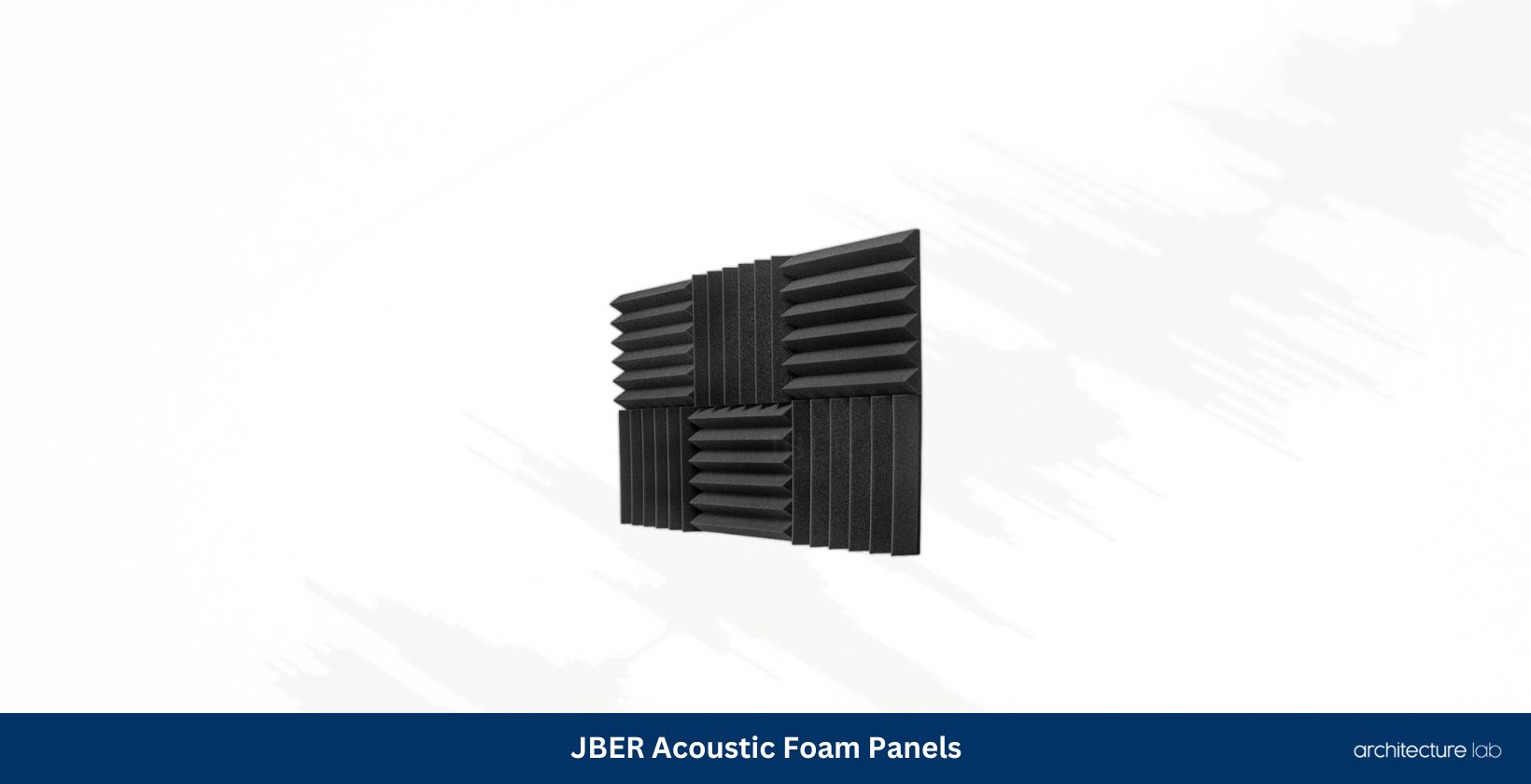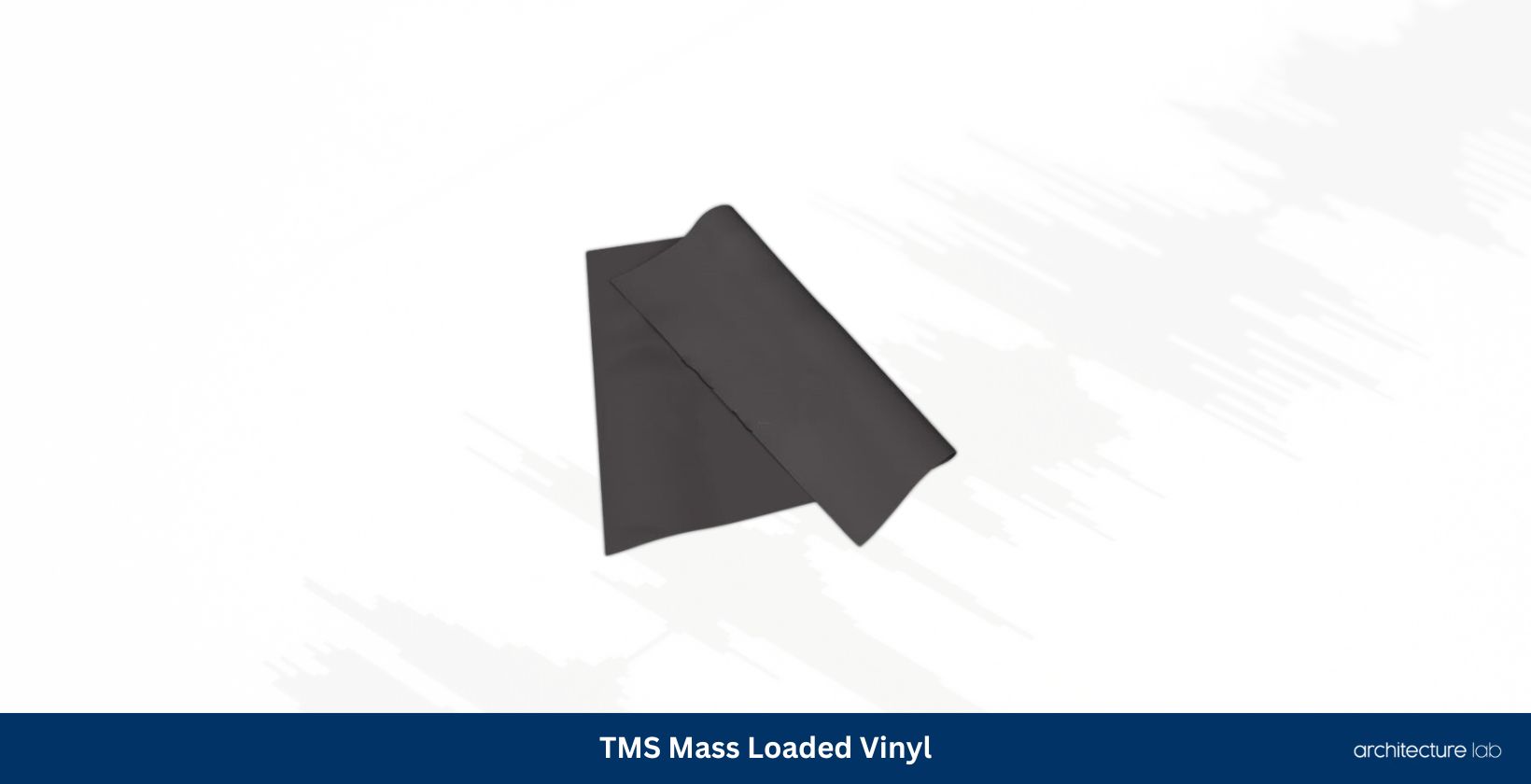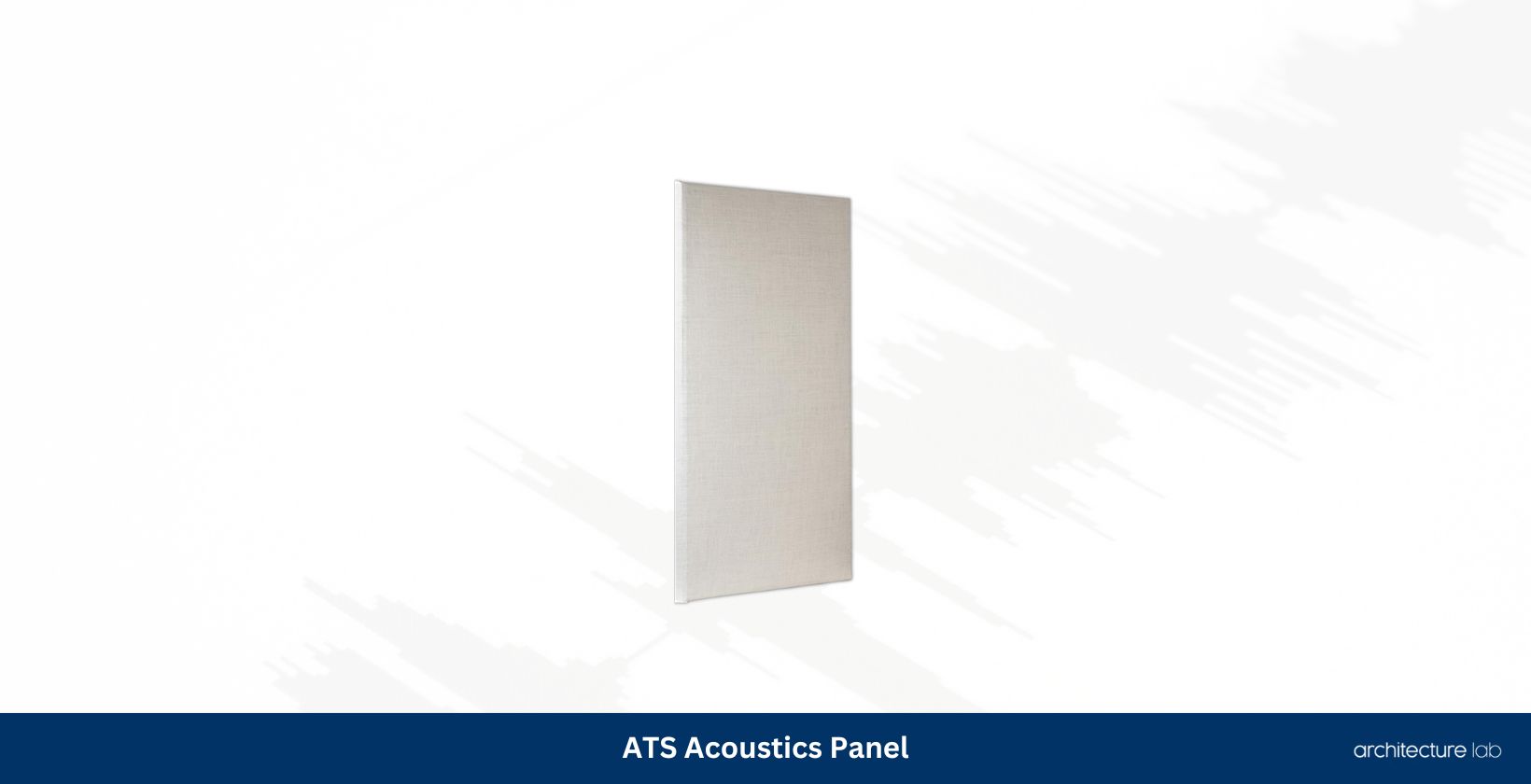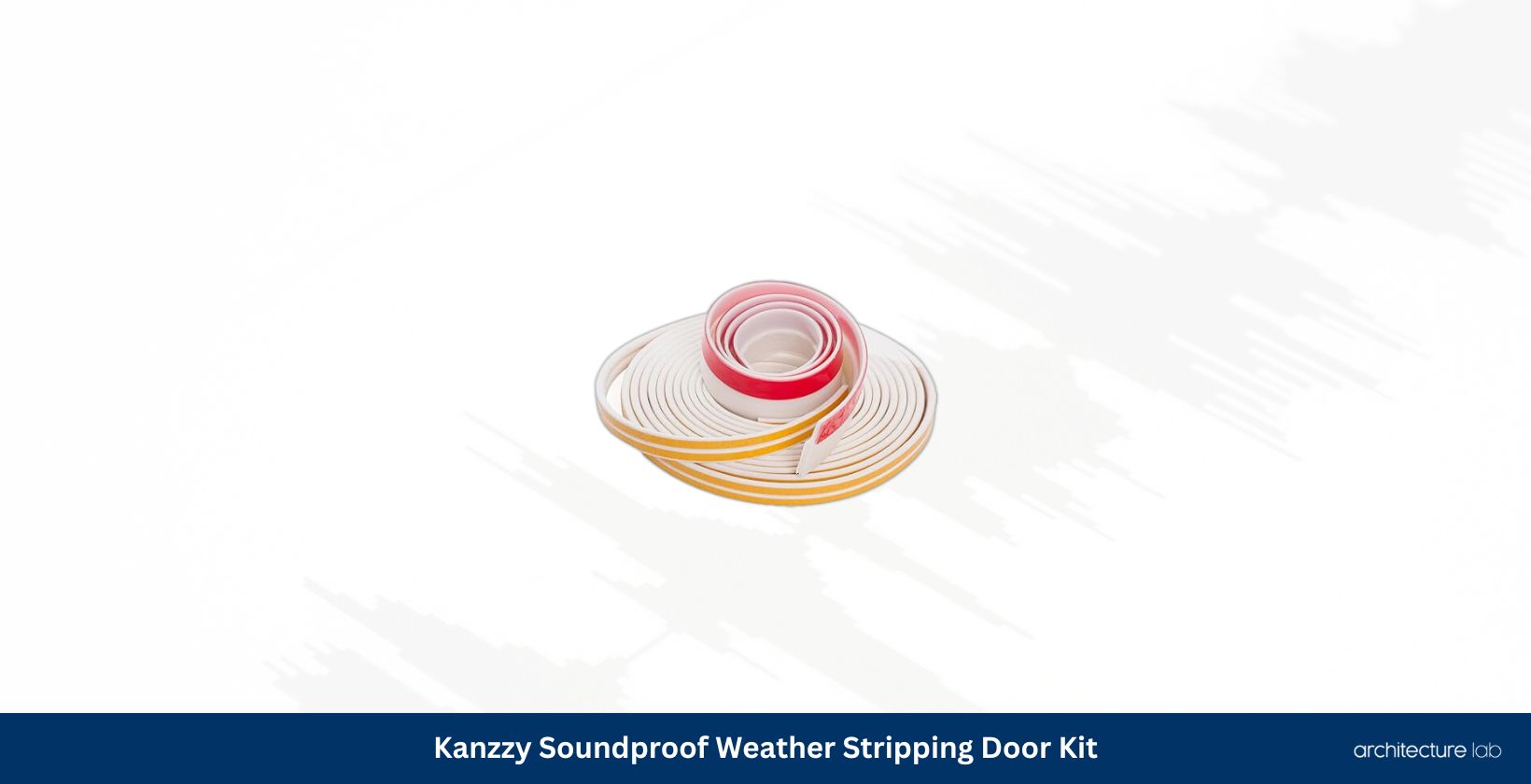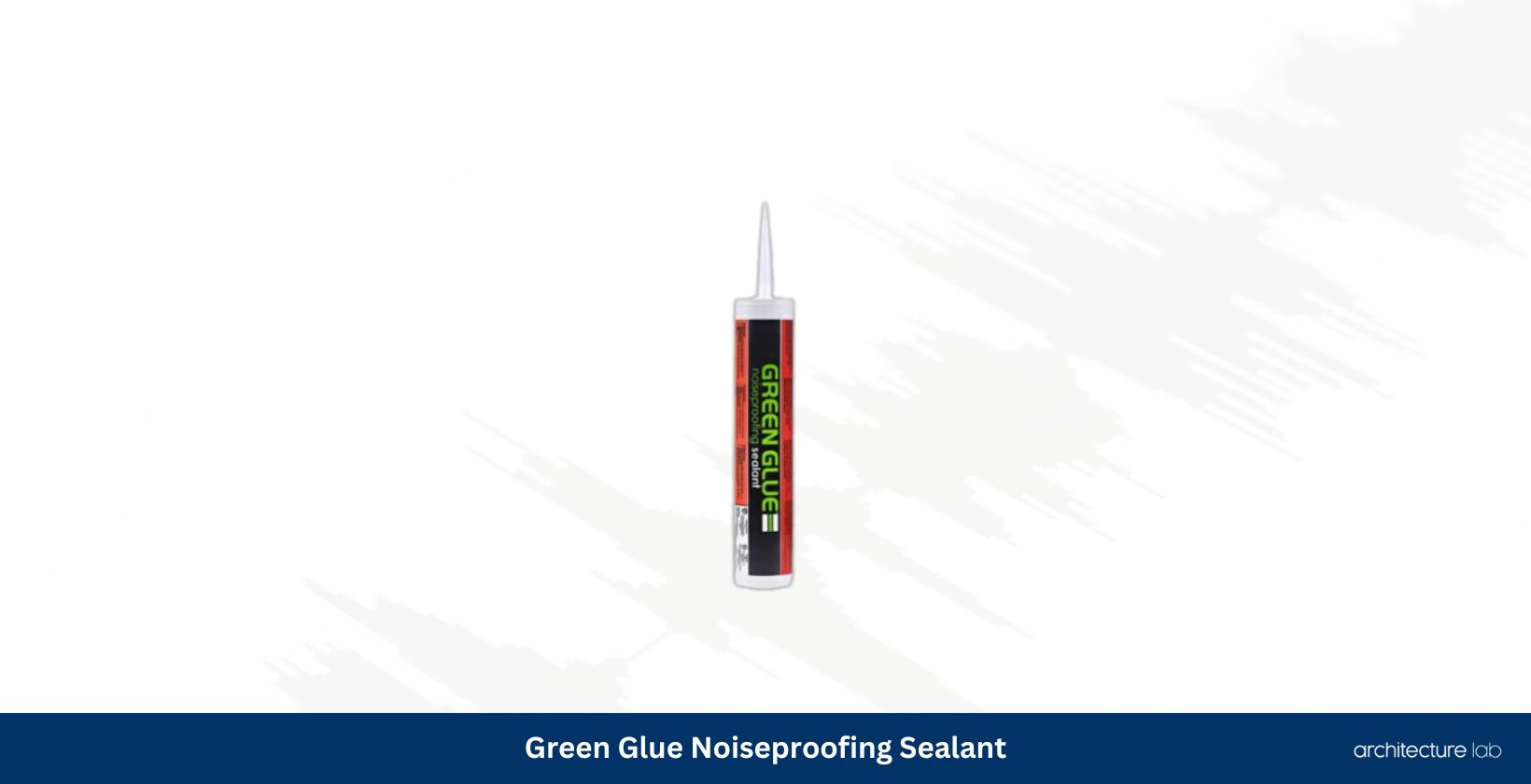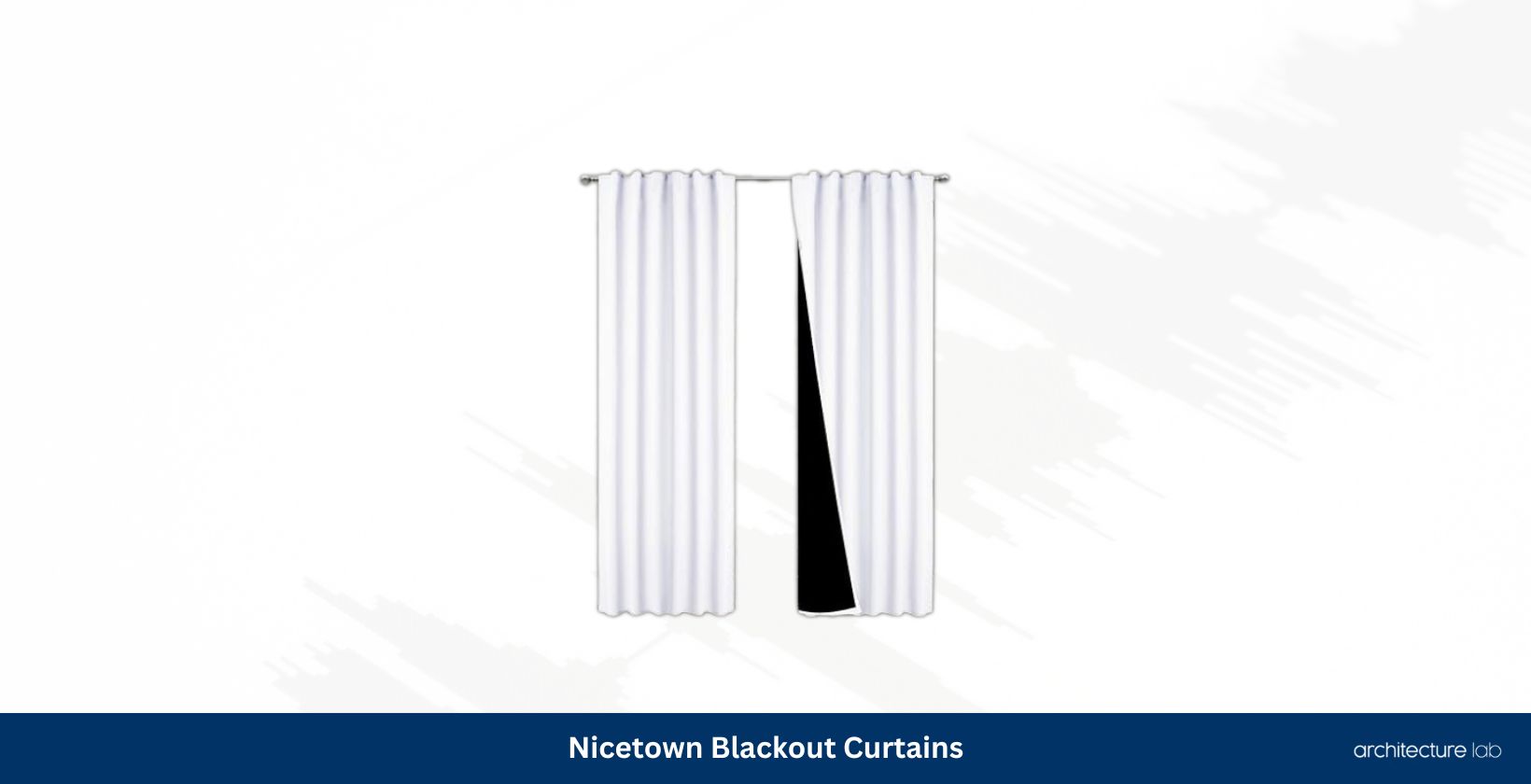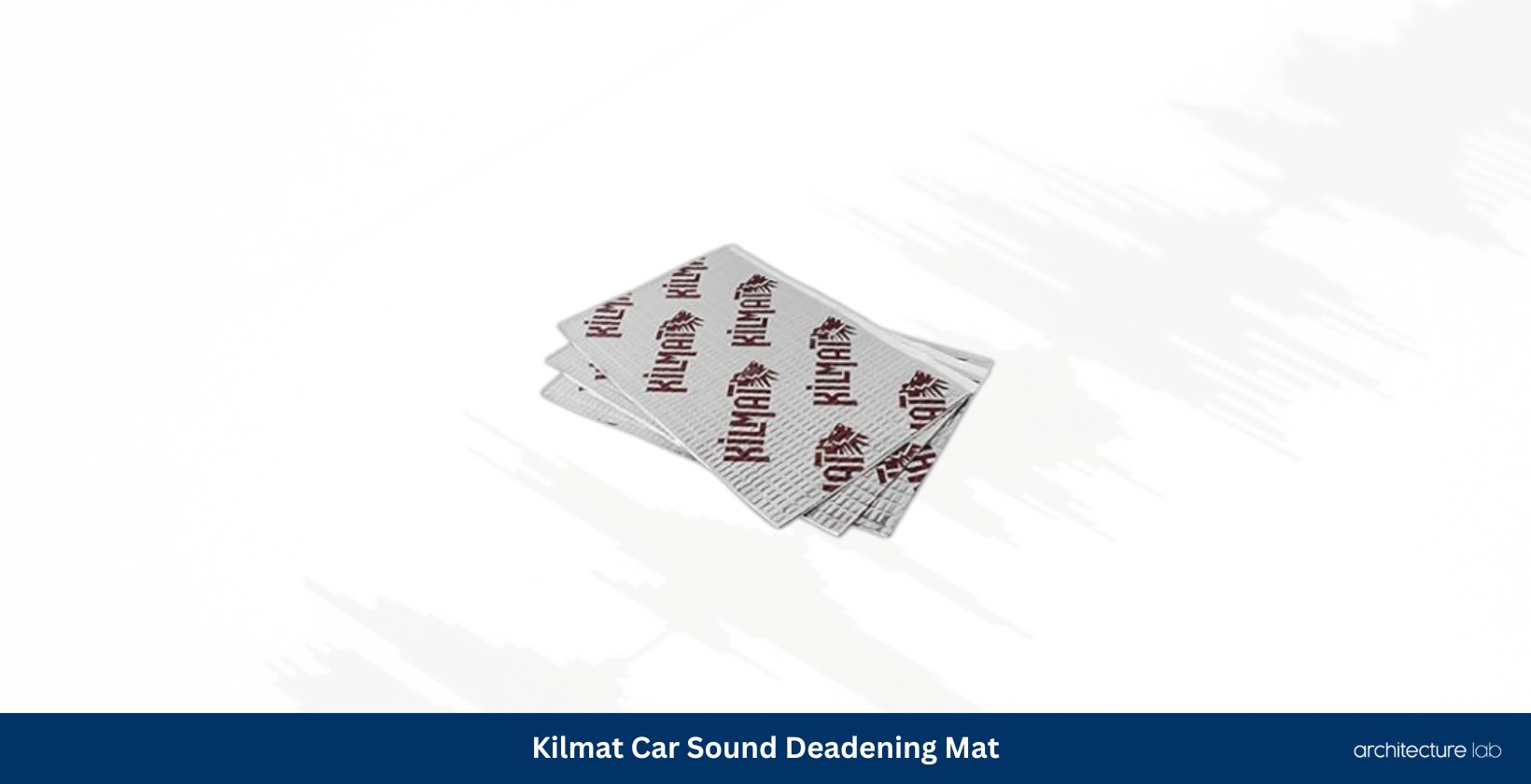Soundproofing materials are designed to reduce noise or completely block sound.
One way or the other, these are essential tools if you want to make your home a quieter place to relax or want to reduce the impact noise makes in your surrounding area.
From soundproof panels to curtains and many more, it can be quite overwhelming and problematic which ones to choose from.
Fortunately, we’ve done the hard part for you. Below are the 9 best soundproofing materials to purchase this year.
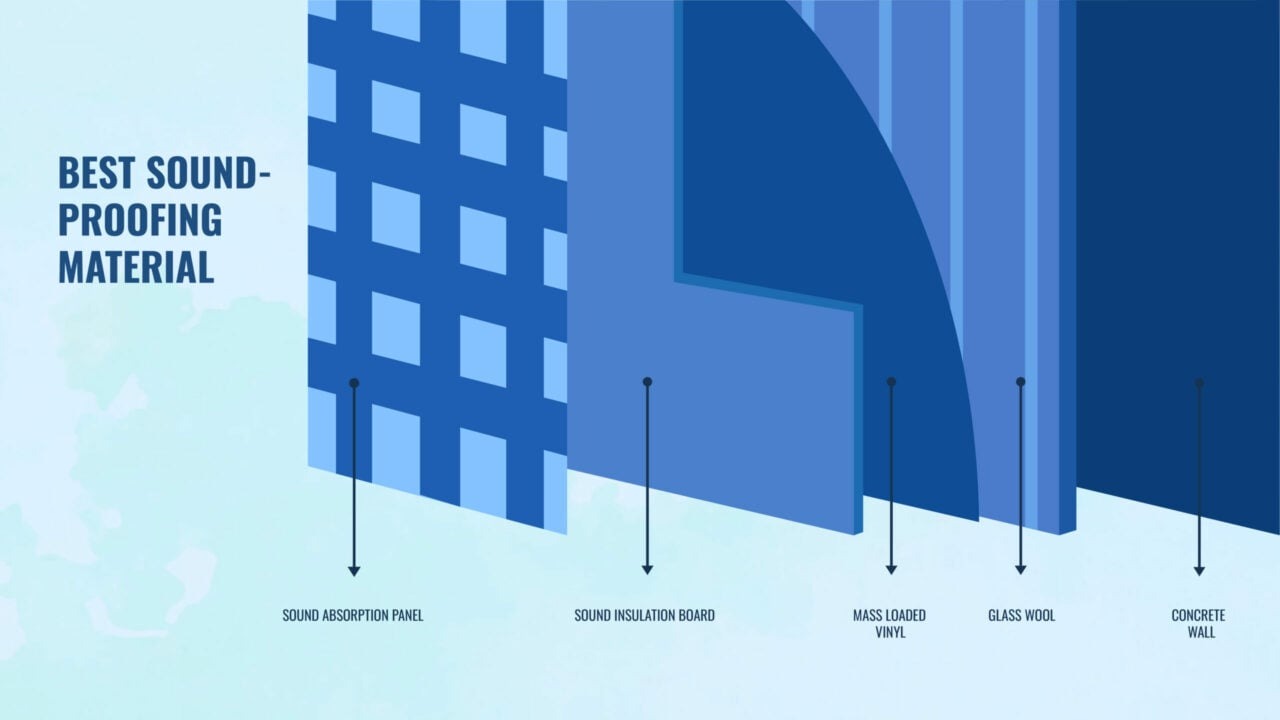
The 9 Best Soundproofing Materials to Choose and Purchase
Here is the list of the 9 best soundproofing materials that you can use to reduce the noise in your home or office.
1. JBER Acoustic Foam Panels – Best for Home Studios
If you are treating a home studio or small workspaces, the JBER 12 Pack Acoustic Foam Panels are one of the best materials when soundproofing walls.
These panels are known to be easy to use, cover a wide area, and have no problems during installation. They are also affordable, making them a viable option for reducing unwanted noise.
While acoustic panels aren’t known to eliminate sound vibrations, they are more than enough to treat small rooms and immensely improve your recordings’ audio quality.
Overall, this product is a good start for small to medium-sized rooms and studios. They are affordable and cover a wide area.
What I Liked:
- Easy to install
- Effective and efficient noise reduction
- Affordable and readily available
- It comes in a 24-pack to cover a wide area
- Great for treating rehearsal spaces, studios, and other areas
What I Didn’t Like:
- Acoustic panels don’t soundproof rooms, but effectively reduce reverb, flutter, echo, and sound reflections.
- You may still need bass traps
2. TMS Mass Loaded Vinyl -Best for Soundproofing Walls
Those people who want to block sound entirely can go ahead and buy the TMS Mass Loaded Vinyl. These have been one of the most popular soundproofing materials in years.
It’s rated as professional-grade wall padding, which means it can also be a good addition for residential use. With an STC rating of 27, these are more than enough to block airborne sounds and acoustic reflections.
In addition, they can easily be installed on hard surfaces, which makes them an ideal material for soundproofing large spaces and areas.
It is affordable and easy to use; even beginners wouldn’t have problems installing these. It doesn’t contain any harmful chemicals, which is a great plus.
What I Liked:
- The thickness of the vinyl sheets improves noise deadening
- Reasonably priced
- Enhances sound quality
- Absorbs noise efficiently
What I Didn’t Like:
- Not good at eliminating low-frequency noise
- It has a smell to it
3. ATS Acoustics Panel – Best Decorative
For those people who aren’t big fans of how wedges and rubber sheets look, the ATS Acoustic Panels are a great option if you want your room or studio to be more appealing to the eyes.
The ATS Acoustic panels are made of a solid wood frame and mineral wool; both are known for their durability.
To top it off, these acoustic panels are made of 100% natural jute, making the entire area more appealing than your traditional sheets and wedges.
Each of these panels measures around 24x48x2 inches with 2 inches of thickness, a good measurement combination if you want to eliminate unwanted sound and improve audio quality.
What I Liked:
- Great for small areas such as living rooms, studios, and auditoriums
- Incredible noise reduction
- Stylish and comes in different colors and designs
- Easy to install
What I Didn’t Like:
- Significantly expensive sound-absorbing material to buy
- It doesn’t have size options
4. Roberts Underlayment Roll – Best Acoustic Underlay
To decrease the transmission of sounds between laminate and hardwood floorings, a floor underlayment might be the best product to buy when soundproofing.
The Roberts Underlayment Rolls are one of the better options if your floor is making too much noise.
One feature that makes this product effective at noise reduction is its made of recycled fibers compressed into a solid mat that is thick enough to reduce sound transmission.
It’s relatively easy to install and adheres to any hard surface.
On top of that, these mats are thick enough to prevent vapor and moisture buildup from your floor, so you don’t have to worry about damaging your floor.
What I Liked
- Easy to install on any floor underlayments
- Affordable choice when soundproofing laminate and wooden floors
- One of the better sound-absorbing materials for floors
- It reduces sound transmission between floors
What I Didn’t Like:
- The fibers on these products might cause asthma.
5. Sure-Max 2 Moving & Packing Blankets – Best Soundproof Blankets
If you are on a tight budget but want to eliminate that outside noise, soundproof blankets might be the best soundproofing material for your needs.
While they are named moving blankets, this soundproofing material is known for its incredible sound-absorbing attributes.
This product is made of polyester and cotton batting, a popular material for acoustic fabrics to absorb sound.
These acoustic fabrics might be heavy, but you can install them on doors, windows, or even windows.
They are also known for their durability and longevity, which is more than enough to suit your needs if you don’t want to break the bank.
Overall, moving blankets are a decent choice, they might be the cheaper option out of all the best soundproofing materials, but they can do their job by absorbing noise effectively while improving the overall sound quality of your recordings.
What I Liked
- A great option for soundproofing windows
- Cheap and always available
- Made of thick and durable materials
- Good for sound absorption
- Easy to install and durable
What I Didn’t Like
- Not the best soundproofing material
- Not for professional use
6. Kanzzy Soundproof Weather Stripping Door Kit – Best for Soundproofing Doors
Most unwanted noise can sneak up in door jams, window sills, and door sweeps. Foam and rubber gaskets such as the Kanzzy Soundproof Weather Stripping Door kit are a great way to prevent outside noise from seeping in.
Unlike other compressive gaskets that can only cover the sides, this product is one of the best soundproofing materials because it can seal it 360 degrees.
As a result, it leaves no gaps between small spaces that noise can leak into. What makes this product even more impressive is it comes with four different types, for four different types of doors.
It’s relatively easy to install. You have to peel off the stick and install it in areas where you feel outside noise might be leaking.
The Kanzzy Soundproof Weather Stripping Door Kit is also one of the cheapest sound absorption solutions for your soundproofing needs.
What I Liked:
- Effectively removes leaking unwanted noise
- Best for sealing door gaps
- The easiest soundproof solution
- It can serve as wall insulation too
- Easy to install and cheap
What I Didn’t Like:
- Not the best option for soundproofing
7. Green Glue Noiseproofing Sealant – Best Acoustic Caulk
For homeowners willing to go the extra mile for their soundproofing efforts, the Green Glue Noiseproofing Sealant might be worth a shot.
This caulk is great for sealing gaps and cracks along doors, windows, ceilings, floorings, and any area of your home where you might feel leaking sounds.
Although this product is not STC-rated, it might be the next step if you have already done all soundproofing methods.
This caulk comes at 29 ounces per tube so you might need a larger caulk gun for this product. However, worry not, as this sealant is easy to apply and doesn’t come out green, as most users fear.
Overall, this acoustic caulk is great for interrupting sound vibrations and greatly improves resilient sound channels’ way of blocking sound pressure from entering the building.
What I Liked:
- Prevents sound from entering an area
- Cheap acoustic coating option
- One of the better sound isolation products for the price
- Available in different colors
- Effectively dissipates sound
What I Didn’t Like:
- Not the best material for soundproofing
- It takes a longer time to cure
- It might be too expensive if you’re soundproofing your entire house
8. NICETOWN 100% Blackout Curtains with Black Liner Backing – Best Acoustic Curtains
Soundproof curtains are another great soundproofing material known for absorbing sound twice as much as traditional curtains.
These soundproof curtains from Nicetown feature two layers of thick polyester fabrics that allow them to absorb sounds efficiently and effectively.
As a result, it can make your studio or room quiet, peaceful, and free from unwanted noise.
These are also better soundproof insulation products as they prevent hot and cold air from escaping or seeping outside. The only problem I have with these is they don’t have STC ratings.
Still, these acoustic curtains are not only known to block unwanted noise, but they also block UV and sunlight rays.
What makes them even more impressive is they come in many designs and colors, which will ultimately make your room even more aesthetically pleasing to the eyes.
What I Liked:
- Blocks UV rays and sunlight
- Available in different colors and sizes
- A better option than traditional curtains
What I Didn’t Like:
- Installation is time-consuming
- Soundproof curtains are heavy and need an adequate structure for support
- Some models and designs aren’t pleasing to the eyes
9. KILMAT Car Sound Deadening Mat – Best for Soundproofing Cars
Soundproofing isn’t only done at home; it can also be done in your car. The KILMAT Car Sound Deadening Mat is another great sound insulation product to reduce unwanted noise from the outside.
This soundproofing material can be installed in many areas in your car, such as under the flooring, carpet, firewall, hood, trunk, or ceiling. It also helps reduce noise transmitted from the engine and on the road.
The KILMAT Car Sound Deadening Mat has a self-adhesive feature for users to stick in their desired location. It can be cut according to the area you are soundproofing.
One impressive feature of this product is its installation indicator which tells you whether or not you have installed the product correctly. Although this can be easy to install, it requires a roller for good measure.
What I Liked:
- One of the best soundproofing materials for cars
- Cold and heat-resistant
- Improves car acoustics
- Reduces road noise
What I Didn’t Like:
- It might be labor-intensive
- It might not be reusable
- Too heavy
Best Soundproofing Materials Comparison Table
| Product | Material | Color/s | Dimensions | Weight | Installation Difficulty |
|---|---|---|---|---|---|
| JBER Acoustic Foam Panels | Fiberglass | Black | 12.99 x 11.93 x 1.73 inches | 15.8 ounces | Medium |
| TMS Mass Loaded Vinyl | PVC | Black | 48 x 10 x 10 inches | 100 lbs. | Medium |
| ATS Acoustics Panel | Wood | Ivory | 24 x 48 x 2 inches | 10.5 lbs. | Medium |
| Roberts Underlayment Roll | N/A | Green | 12 x 12.2 x 60 inches | 45.5 lbs. | Easy |
| Sure-Max Soundproof Blankets | Cotton, Polyester | Black or blue | 80 x 72 x 0.25 inches | 5.5 lbs/blanket | Easy |
| Kanzzy Soundproof Door Strips | Silicon | White | 7.1 x 2 x 7.1 inches | 12.3 ounces | Easy |
| Green Glue Noiseproofing Sealant | N/A | N/A | 14 x 8 x 6 inches; 5.64 inches | N/A | Easy |
| NICETOWN Soundproof Curtains | Polyester, Polyester Blend | 13 Colors available | 52 x 84 x 0.5 inches | 6.26 lbs. | Easy |
| KILMAT Soundproofing Mat | Aluminium foil | Silver | 17.5 x 3.5 x 11 inches | 17 lbs. | Medium |
The Common Types of Soundproofing
As you may have already noticed, different soundproofing materials are available today. Each of them has its way of reducing and absorbing sound.
Fiberglass Insulation
Fiberglass insulation comes in different shapes and sizes and can be used in various applications when reducing sound entering the room or space.
In addition, they can also be used when making foam panels in theatres, home studios, and commercial buildings.
This soundproofing material effectively reduces the noise that enters and leaves the room. It can also improve the internal acoustics of the space for better audio quality.
Soundproof Curtains
Soundproof curtains are often used as a temporary division or partition to reduce the passing of sound in spaces such as theatres and backstage.
When soundproof curtains are placed within optimal positions, they significantly reduce the propagation of sounds within this partitioned area.
They are considered one of the best soundproofing materials if you only do it for partitioning spaces to prevent sound from spreading.
However, most fabrics used for curtains are expensive and usually measured before making one.
Soundproof Paint or Acoustic Coating
While soundproof paint might be used for sound dampening, it is applied the same way as your typical floor or wall paint by a brush or a roller.
The concept of using soundproof paint for soundproofing areas is to make a thicker layer of coating. As a result, it might have the potential to deflect sound traveling inside.
However, an acoustic coating isn’t the best soundproofing material and is not known to produce good results.
An acoustic coating isn’t good for reducing sound because of the lack of mass once applied.
While spray painting can provide a thicker layer of coating, the results aren’t reliable enough to conclude this option is great.
But if you want to use all the means necessary to reduce the transmission of sound, this material is a better choice than your traditional wall paint.
Acoustic Panels
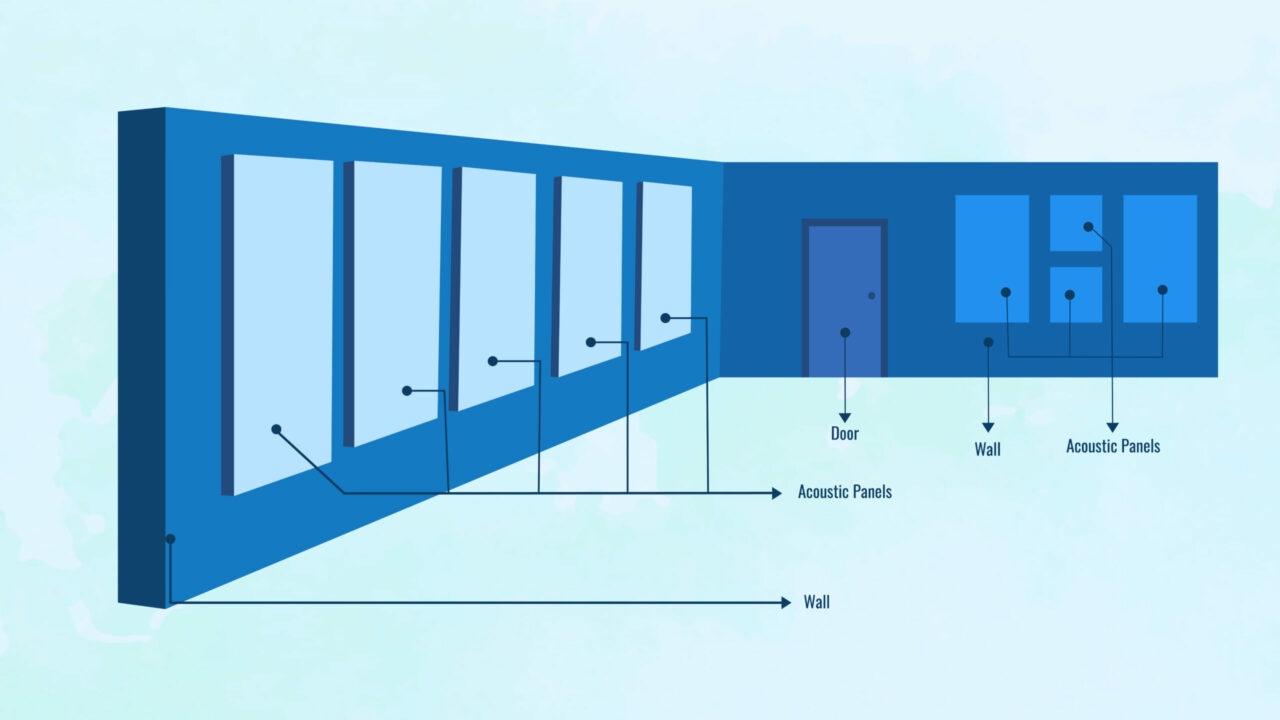
Acoustic panels are often directly fitted into ceilings to provide improved acoustic control.
Acoustic panels are one of the best soundproofing materials because they come in various shapes, sizes, and densities.
Regardless of how big the space is, acoustic panels can significantly improve the acoustical qualities of a certain area. The only problem with acoustic panels is they have to be installed by a professional.
Acoustic Caulk
Like sealants, an acoustic caulk works similarly by filling small cracks, gaps, and tiny spaces between rooms.
Sound can travel even in the tiniest hole possible. This is why acoustic caulks are considered more as a complementary soundproofing solution than the primary solution.
Like most soundproofing materials, an acoustic caulk is often an added solution when plasterboards and drywall show their weakness by not filling the gaps between them.
The only problem with this soundproofing material is it’s not the answer to what you want to achieve to improve acoustic levels.
Soundproof Drywall
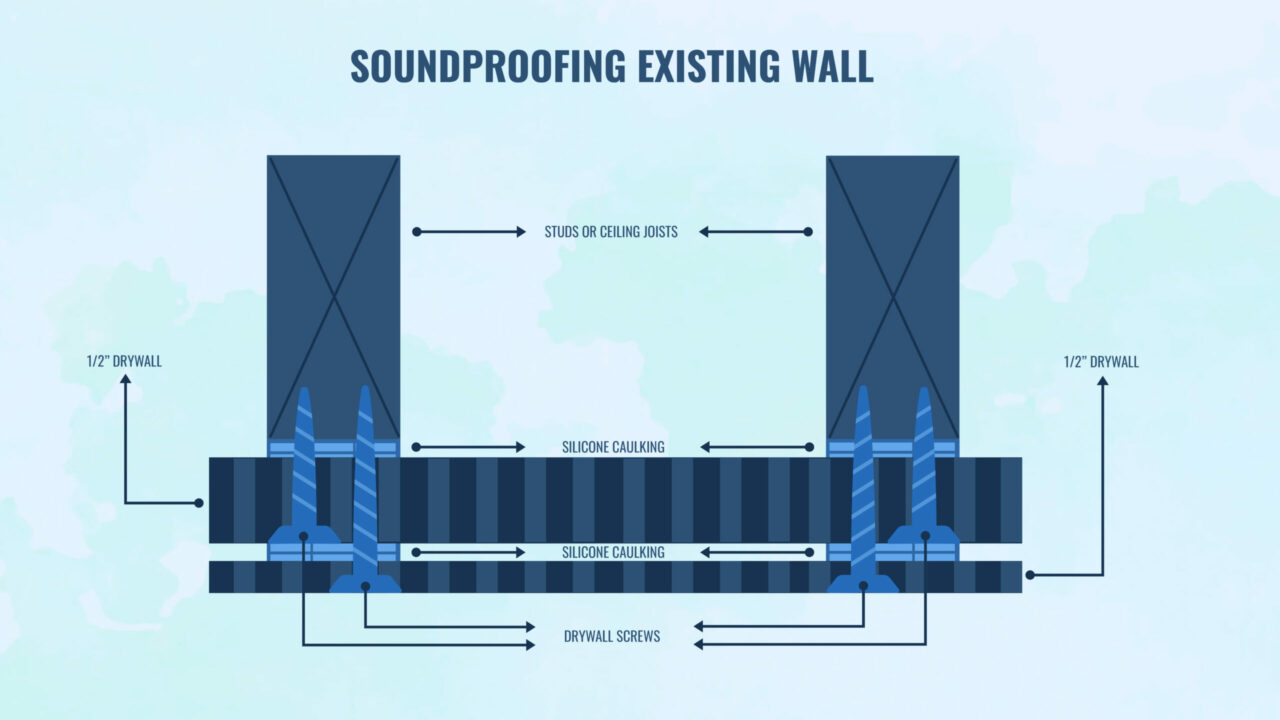
Soundproof drywall, or plasterboards, is also one of the more effective soundproofing materials.
This type of soundproofing material has different thicknesses depending on the user’s needs. In addition, the thickness promotes an improved sound transmission class than any other type of material.
In addition, soundproof drywall is usually made in combination with various materials such as layers of gypsum boards, steel, and many more.
These materials aim to increase the mass and density to block noise effectively.
To achieve amazing results when soundproofing spaces, it is best to use soundproof drywall in conjunction with several soundproofing methods, such as sealants, tapes, isolation membranes, and many more.
Acoustic Sealants
Acoustic sealants work on the concept of decoupling and are often used during the construction of a room, house, or building.
It can also be used in conjunction with other soundproofing materials such as drywall, plasterboard, or isolation membrane.
As its name suggests, they are usually used for sealing gaps, cracks, open spaces, sea holes, screw holes, and many more. It works by minimizing the sound vibrations that pass through the walls.
Acoustic Mineral Wool Insulation
Acoustic mineral wool insulation is great for absorbing thermal and acoustic energies.
They often come in different varieties, thicknesses, and densities. Mineral wool insulation is often installed on cavities such as stud walls and is usually used in professional and household soundproofing.
It’s not only used for reducing or eliminating sound waves entirely, but they are also great at filling gaps between the walls and studs.
As a result, these fillings prevent sound waves from entering these cracks, crevices, and cavities from seeping in. This soundproofing material might be known for its rigidity, but they are easy to cut and install.
Acoustic Foam
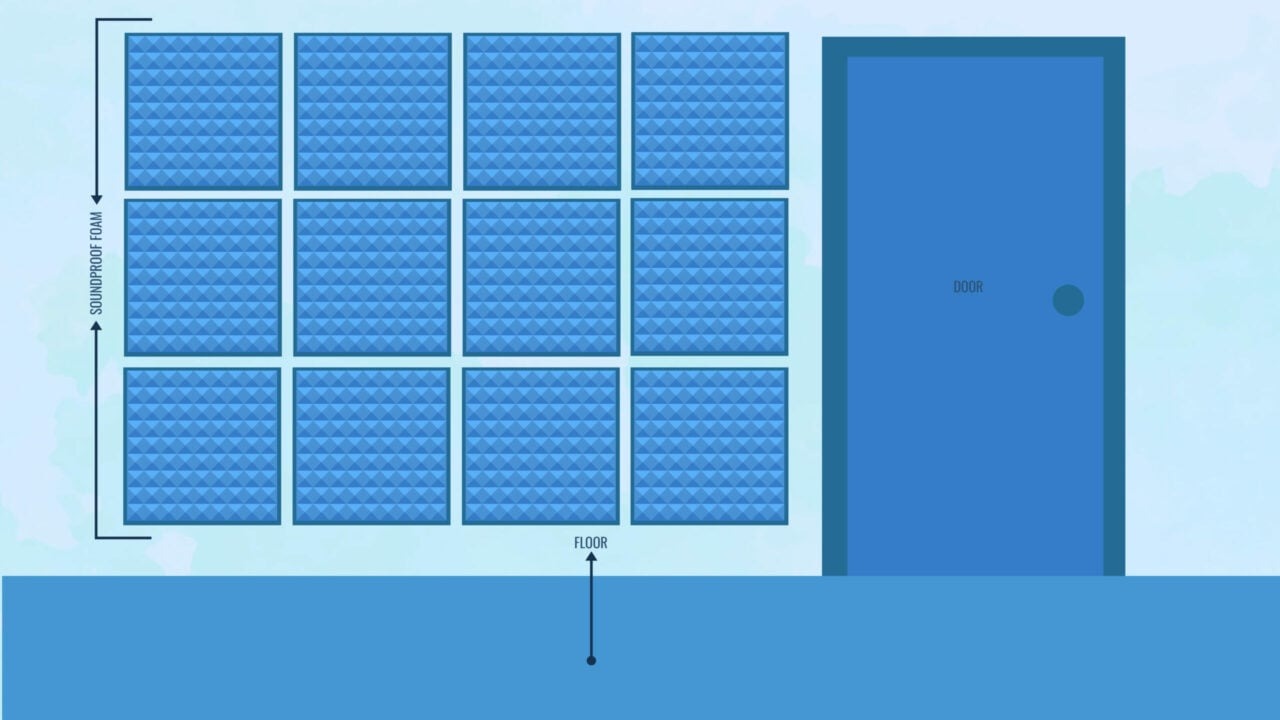
Acoustic foam is another popular soundproof material commonly known as studio foam. They are often used in home and professional studios and can be convoluted, chamfered, or flat.
As I’ve mentioned, they are often used in studios to improve the audio quality of recordings. Acoustic foam follows the concept of sound absorption and the re-calibration of internal acoustics.
While they make a significant difference to internal acoustics and values, they are not entirely the solution if you want to totally block noise from an area.
It’s also important to note that this soundproofing material comes in different shapes, sizes, and densities.
As a result, they are more effective when used in conjunction with other soundproof schemes, along with correct positioning and layout.
When buying this type of material, you should also consider what surface the area has and how much area is covered.
Soundproof Floor Underlay
Floor underlayments are a good way to minimize sound transmissions between hardwoods and engineered floors that occur naturally.
There are various types of soundproof floor underlay but felt underlayment is the superior choice. Felt underlayments are often made with layers that are compressed and heat-treated.
As a result, these combinations make it more of a denser material capable of reducing sound transmissions between floors.
They make for a decent soundproofing solution but are better used in conjunction with other materials and methods for better effectiveness.
Acoustic Membrane
There are many types of acoustic membranes on the market. Some are better performing, while others are heavier.
Regardless, acoustic membranes are often rated according to how many decibels they can reduce across different frequencies.
Like panels and wedges, an acoustic membrane’s thickness and density greatly impact its effectiveness. That is why you have to consider several factors when choosing one.
Acoustic membranes are also a material known for converting sound energy into heat. When sound passes through these membranes, it creates friction, resulting in heat traces.
Soundproof Wallpaper
Like an acoustic coating, there is so much debate regarding the effectiveness of soundproof wallpaper. Their efficacy remains to be a topic amongst soundproofers.
Mass is an important concept of soundproofing, and it can be difficult to have a thickness adequate enough for wallpapers to reduce unwanted noise effectively.
However, soundproof wallpapers made of closed-cell polyethylene foam are known for their sound-absorbing capabilities.
Buying Guide for the Best Soundproofing Material
Before you head out to your local store, you might want to consider a few things to get the best material for your soundproofing needs. Check these out below.
NRC Rating
NRC, better known as noise reduction coefficient, is a value noting the capacity of the soundproofing material to absorb or reflect sound.
The noise reduction coefficient value ranges from 0 to 1, meaning the higher the NRC rating, the better the material for noise reduction.
STC and IIC Rating
STC, commonly known as sound transmission class, is a rating given to soundproofing materials on how they can prevent noise transmission.
Like the NRC rating, the higher the rating is, the more effective the material is when blocking out noise.
On the other hand, IIC or impact isolation class is the rating in which a value is given to a material’s ability to absorb noise. Similar to NRC and STC ratings, the higher the value, the better the performance.
| STC | What you can hear at this level* |
|---|---|
| 25 | Soft speech can be heard and understood |
| 30 | Normal speech can be heard and understood |
| 35 | Loud speech audible but not intelligible |
| 40 | Loud speech audible as a murmur, heard but not understood |
| 45 | Loud speech can be heard, the threshold at which privacy begins |
| 50 | Loud sounds can be heard but faintly, indistinguishable |
| 60+ | Good soundproofing starts here; most sounds do not disturb neighbors |
| *Values in this table relative, as they are influenced by background noise levels in the receiving room, the greater the better perceived sound insulation | |
Materials Used
Materials used for soundproofing matter a lot! Sound waves are also called vibrations. As a result, when materials decrease vibrations, it also reduces the transmission of noise. Considered these things below:
- Density – as the density increases, the sound absorption increases as well. Remember that density is defined as the mass of a unit volume of a material substance.
- Thickness – similar to the concept of density, the thicker the materials used, the better at absorbing sounds.
- Porosity – due to the cellular structure of porous materials, sound waves can’t easily pass through an open path. As a result, it creates a wavy or zigzag path that straight sound waves can’t pass through and is then transformed into heat when captured.
Noise Level
The intensity or noise level someone has to reduce or remove entirely will ultimately be the deciding factor when choosing the best soundproofing materials.
For example, if you want to reduce vibration, reverberation, or echo in a small room, an acoustic foam will be more than enough.
In addition, acoustic panels, blankets, curtains, and pads will also be good options, as thick layers of fabric convert sound energy into heat.
However, if you want to block out noise from entering your space coming from heavy-duty machines, you might have to rely on professional soundproofing solutions for better sound insulation.
Circulation of Sound
There are often two types of noise interference, structure-born and airborne.
If you want the right soundproofing material, you want to know how the sound travels from the source toward the area.
Some materials are better at reducing airborne noise interferences, whereas some are designed to eliminate structure-borne noise.
How do professionals soundproof a room?
Most professionals rely on acoustic panels to soundproof a room or a studio. While many options are available, foams and wedges are the superior choices for professionals.
If professionals treat large spaces, a soundproof underlay combined with soundproof drywall is the better choice.
But, always remember each material is great when used in conjunction with other materials as it increases effectivity and efficiency when reducing or eliminating unwanted noise.
As a result, a professional may take a different approach from the other, depending on several factors such as space, type of noise, and noise level
How do I block noise on a shared wall?
One of the best materials you can use to block noise on a shared wall is acoustic foam or wedges.
Soundproof curtains are also good as they often act as an acoustic barrier to reduce the transmission of one sound to the other.
How to soundproof a bedroom?
There are plenty of materials that can be used when soundproofing a bedroom, such as wedges and panels. Soundproof curtains and blankets are great options!
You can also use those products in combination with soundproofing door strips. Using strips is important because sound travels even in the tiniest cracks and gaps.
What is the cheapest option when soundproofing effectively?
One of the cheapest soundproofing options is panels. They are cheap and are always available on the market.
What makes them ideal for budget-oriented soundproofers is their ability to cover a wide area while reducing noise levels efficiently.
Conclusion
We’re so grateful for the time you’ve invested in exploring the best soundproofing materials with us. It has been quite an adventure!
Each product we’ve encountered has its unique benefits, and hopefully, the reviews have provided valuable insights as you navigate the world of soundproofing. Out of these nine products, here are our top three recommendations:
If you seek to create a quieter home studio or regulate noise in small workspaces, the JBER Acoustic Foam Panels are an ideal option. These panels offer effective noise reduction and suit small to medium-sized rooms and studios perfectly.
For those searching for a formidable solution to soundproof walls and large spaces, the TMS Mass Loaded Vinyl is a good option. Its professional-grade wall padding and STC rating of 27 help block airborne sounds and significantly reduce acoustic reflections.
Lastly, if you’re not only after high performance but also aesthetics, the ATS Acoustics Panel is the right choice. It provides exceptional noise reduction while adding a stylish touch to your living spaces, studios, and auditoriums.
Remember, the choice of soundproofing material can make a significant difference to the quality of an acoustic environment. With these top recommendations, we aim to equip you to create a serene, noiseless space that is pleasing to both the ears and the eyes.
Imagine the possibilities these products open up. Dream about the quality of life that a quieter space brings about. Whether this means a peaceful night’s sleep, productivity-enhancing workspaces, or professional-sounding home studios, the change is in your hands! So go ahead, take the plunge, and transform your surroundings – silence is, after all, golden!
Once again, we appreciate your time and hope this guide has been educational and helpful in your soundproofing journey. Until next time, keep exploring, keep innovating, and stay excited about creating tranquil living and workspaces with the best soundproofing materials!

